
Are you craving a taste of adventure? Dive into the vibrant world of Japanese cuisine!
Japanese food offers a rich tapestry of tastes and traditions, from the delicate flavors of sashimi to the comforting warmth of ramen.
We’ve detailed the top 15 dishes every food lover must try, each with a unique story and flavor profile.
There is an extended list of 35 additional dishes for people who want to read beyond these 15 dishes.
Imagine biting into the crispy, light tempura texture or savoring the umami-rich miso soup broth.
These dishes not only tantalize your taste buds but also glimpse Japan’s culinary heritage.
Are you ready to expand your palate? Keep reading to explore these exquisite dishes and discover even more Japanese culinary gems!
List of Delicious Japanese Food Items to Try
1. Sushi

- Description: Sushi consists of vinegared rice and various toppings, such as seafood, vegetables, and sometimes tropical fruits.
- Ingredients: Vinegared rice, nori (seaweed), raw fish, vegetables like cucumber and avocado, and sometimes tropical fruits.
- Preparation and Cooking Methods: Rice is seasoned with vinegar, sugar, and salt, then cooled. Toppings like fish are sliced and placed on the rice or rolled in nori.
- Serving Suggestions: Served with soy sauce, wasabi, and pickled ginger.
- Taste Profile: A balance of tangy, sweet rice with fish’s fresh, oceanic flavor.
- Nutritional Information: Low calories, high in protein, and rich in omega-3 fatty acids, especially when made with fatty fish like salmon or tuna.
2. Sashimi

- Description: Thinly sliced, raw fish or seafood, served without rice.
- Ingredients: Fresh fish like tuna, salmon, halibut, and sometimes octopus or shellfish.
- Preparation and Cooking Methods: Fish is expertly sliced into thin pieces.
- Serving Suggestions: Usually served with soy sauce and wasabi.
- Taste Profile: Fresh, clean taste of the sea, with a buttery texture in fatty fish.
- Nutritional Information: High in protein and omega-3 fatty acids; low in calories.
3. Tempura
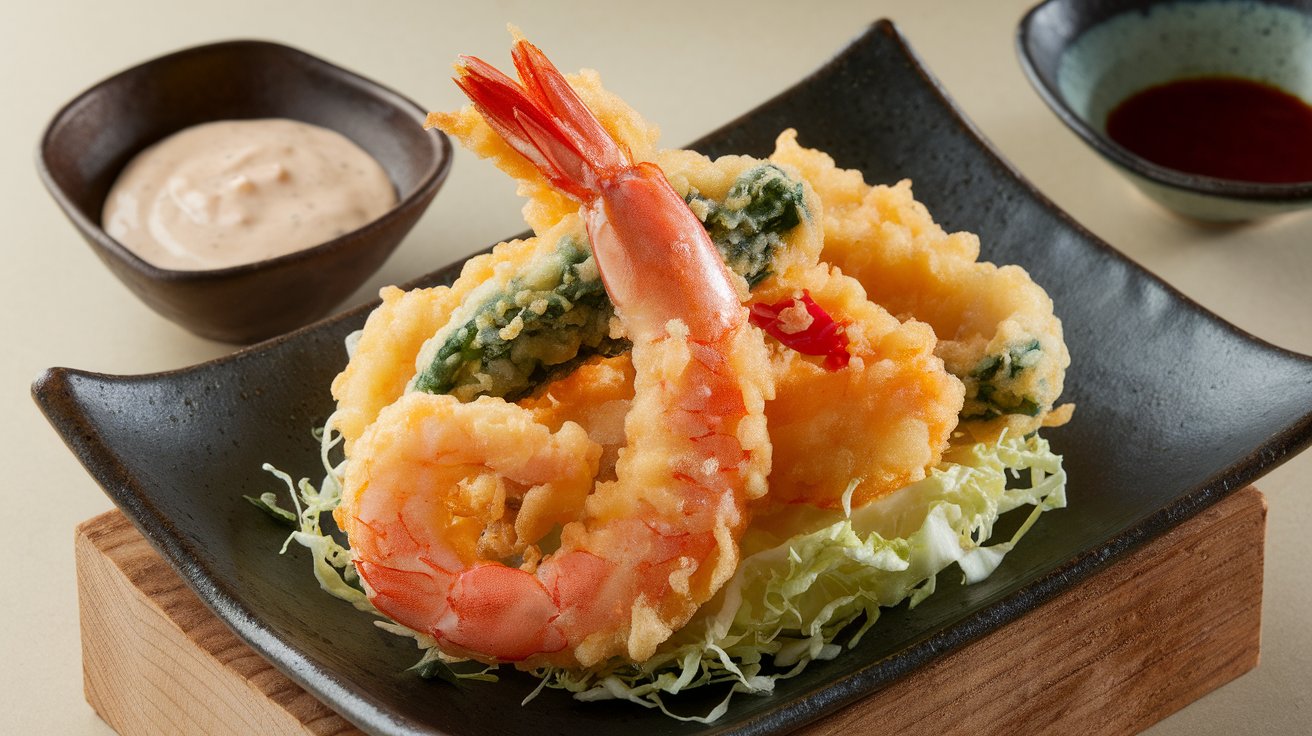
- Description: Seafood or vegetables coated in a light batter and deep-fried.
- Ingredients: Shrimp, squid, sweet potatoes, bell pepper, green beans, and tempura batter (cold water, flour, and egg).
- Preparation and Cooking Methods: Ingredients are dipped in batter and fried in hot oil until crispy.
- Serving Suggestions: It is served with a dipping sauce made from dashi, mirin, and soy sauce, often with grated daikon.
- Taste Profile: Crisp and light outer shell with tender, flavorful inside.
- Nutritional Information: Higher in calories due to frying, but can be a good source of vitamins if made with vegetables.
4. Ramen
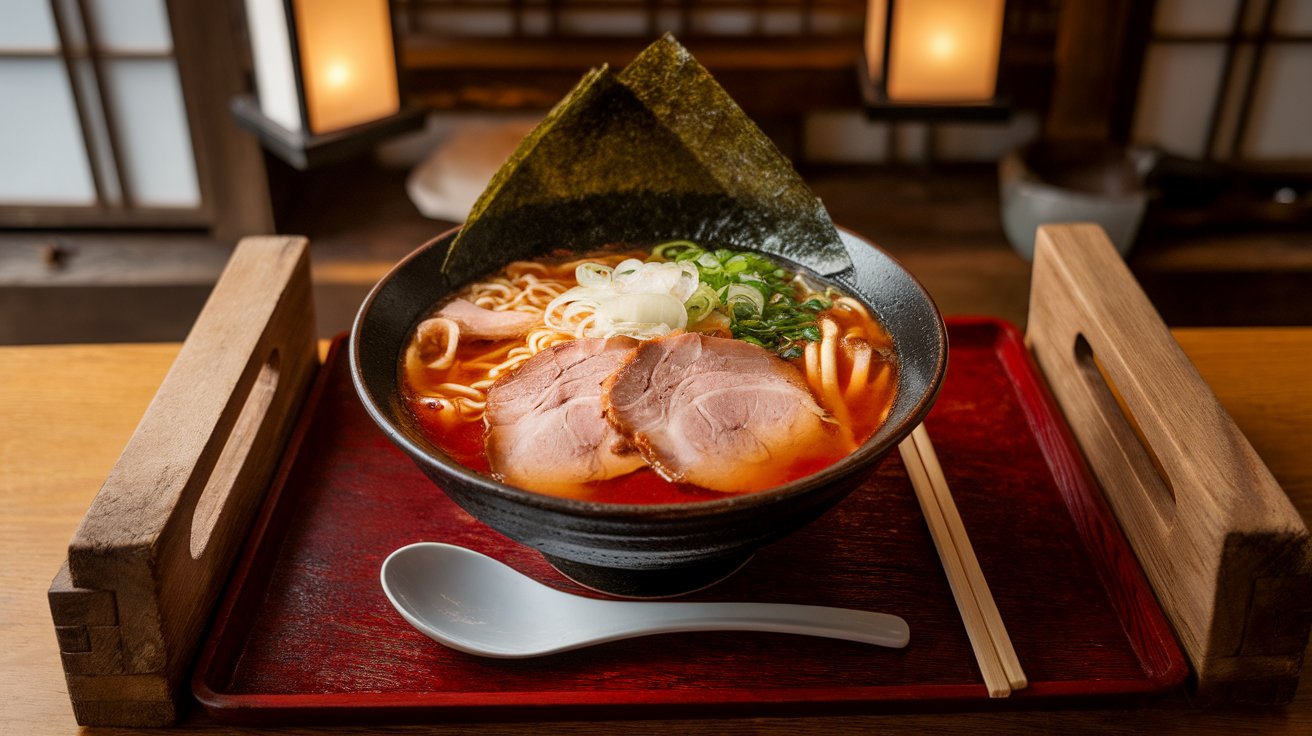
- Description: A noodle soup with various broths and toppings.
- Ingredients: Wheat noodles, broth (chicken, pork, beef, or seafood), toppings like sliced pork, green onions, seaweed, and boiled eggs.
- Preparation and Cooking Methods: Noodles are boiled and served in a flavored broth with added toppings.
- Serving Suggestions: Often customized with additional toppings like bamboo shoots, corn, butter, and chili oil.
- Taste Profile: Rich, savory, and umami-packed with varying levels of saltiness and spice.
- Nutritional Information: It can be high in sodium, but it also offers protein and depends on the variety of toppings for additional nutrients.
5. Udon
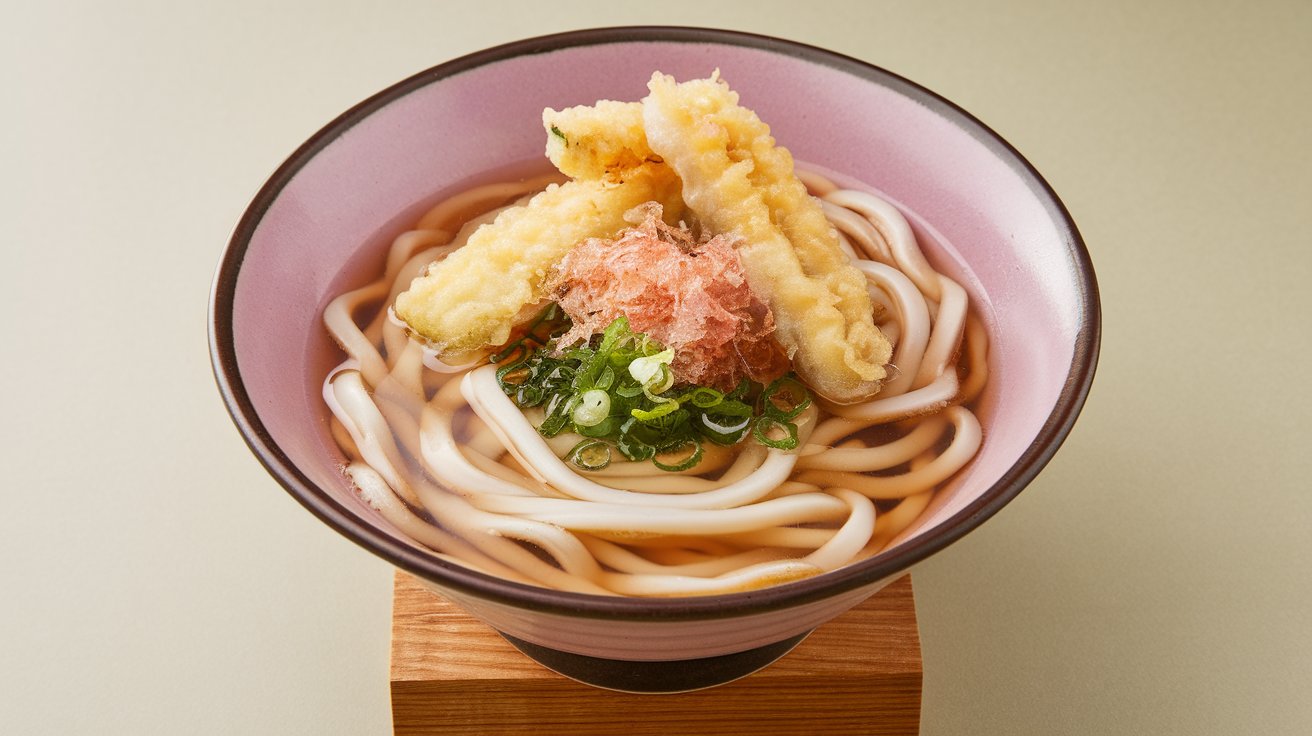
- Description: Thick wheat noodles served hot in a broth or cold with a dipping sauce.
- Ingredients: Udon noodles (wheat flour), broth (dashi, soy sauce, mirin), scallions, and sometimes tempura or tofu.
- Preparation and Cooking Methods: Noodles are cooked and served either in a hot broth or chilled with a separate dipping sauce.
- Serving Suggestions: May be garnished with sliced scallions, nori, or tempura.
- Taste Profile: Chewy and soft noodles with a mild and subtly sweet broth.
- Nutritional Information: Generally low in calories but can be high in sodium due to the broth.
6. Soba

- Description: Thin noodles made from buckwheat flour, served either chilled with a dipping sauce or in a hot broth.
- Ingredients: Buckwheat, water, and wheat flour (sometimes added to help bind the noodles).
- Preparation and Cooking Methods: The noodles are boiled and then either cooled and served with dipping sauce or served hot in broth.
- Serving Suggestions: Garnished with green onions, wasabi, and nori; may include tempura or boiled egg.
- Taste Profile: Nutty flavor with a firm texture, complemented by a savory dipping sauce.
- Nutritional Information: High in protein and fiber, gluten-free if made purely from buckwheat.
7. Takoyaki

- Description: Ball-shaped, grilled octopus snacks, popular at festivals.
- Ingredients: Batter (flour, eggs, dashi), cooked octopus pieces, tempura scraps, pickled ginger, and green onion.
- Preparation and Cooking Methods: Mixed ingredients are poured into molded pans and cooked until golden brown.
- Serving Suggestions: Topped with takoyaki sauce, mayonnaise, green laver, and bonito flakes.
- Taste Profile: Crispy outside with a gooey inside, this dish features a savory flavor with a hint of sweetness from the sauce.
- Nutritional Information: Provides protein from the octopus but is relatively high in calories from the batter and toppings.
8. Okonomiyaki
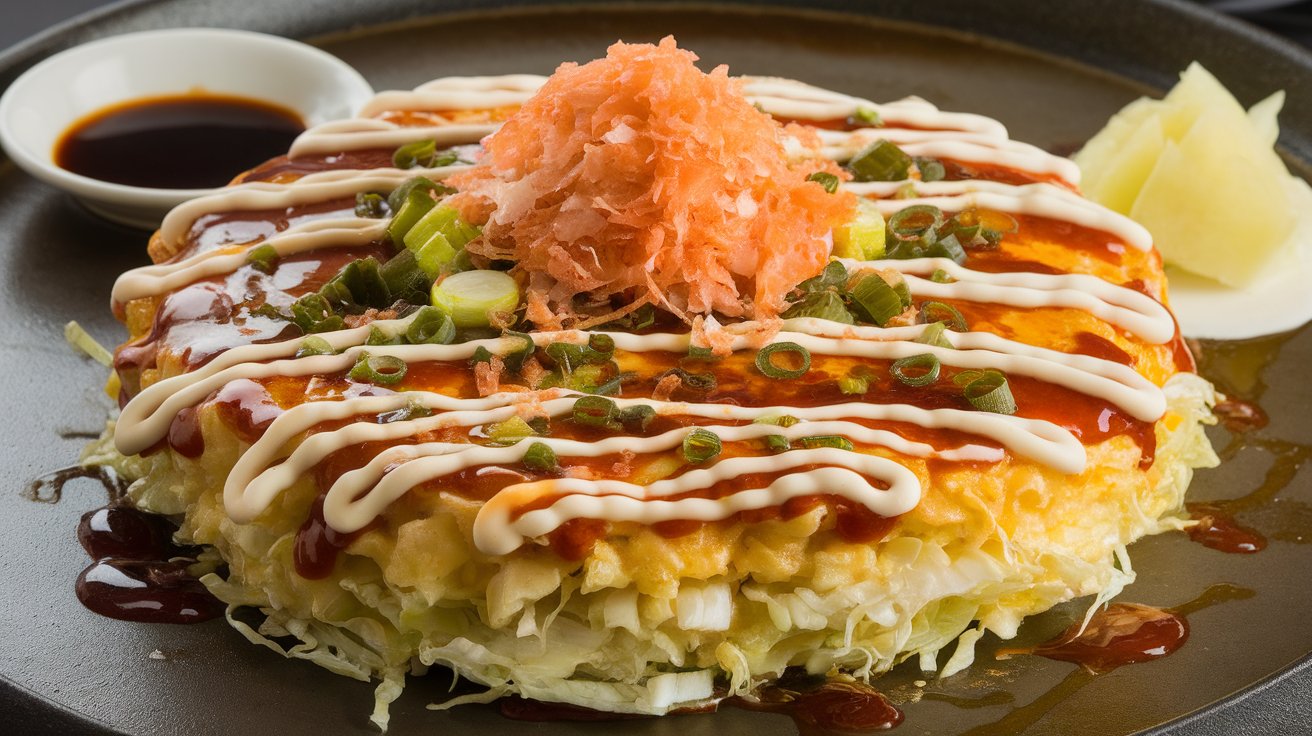
- Description: A savory pancake containing various ingredients, often described as “Japanese pizza.”
- Ingredients: Batter (flour, eggs, cabbage), various fillings like seafood, pork, and cheese, topped with okonomiyaki sauce, mayonnaise, green onions, and bonito flakes.
- Preparation and Cooking Methods: Ingredients are mixed into the batter and grilled to a crispy finish on both sides.
- Serving Suggestions: Drizzled with okonomiyaki sauce and mayonnaise sprinkled with bonito flakes and seaweed powder.
- Taste Profile: Savory with a complex flavor profile from the rich toppings and tangy sauce.
- Nutritional Information: High in calories, but can be a good source of vitamins from cabbage and other vegetables.
9. Tonkatsu

- Description: Breaded and deep-fried pork cutlet.
- Ingredients: Pork loin or filet, panko breadcrumbs, flour, eggs.
- Preparation and Cooking Methods: Pork is coated in flour, dipped in beaten eggs, covered in breadcrumbs, and fried until golden.
- Serving Suggestions: It should be served with shredded cabbage, rice, miso soup, and tonkatsu sauce (a thick, sweet sauce).
- Taste Profile: Crunchy exterior with a juicy, tender interior.
- Nutritional Information: High in protein and fat, particularly if made with pork loin.
10. Yakitori
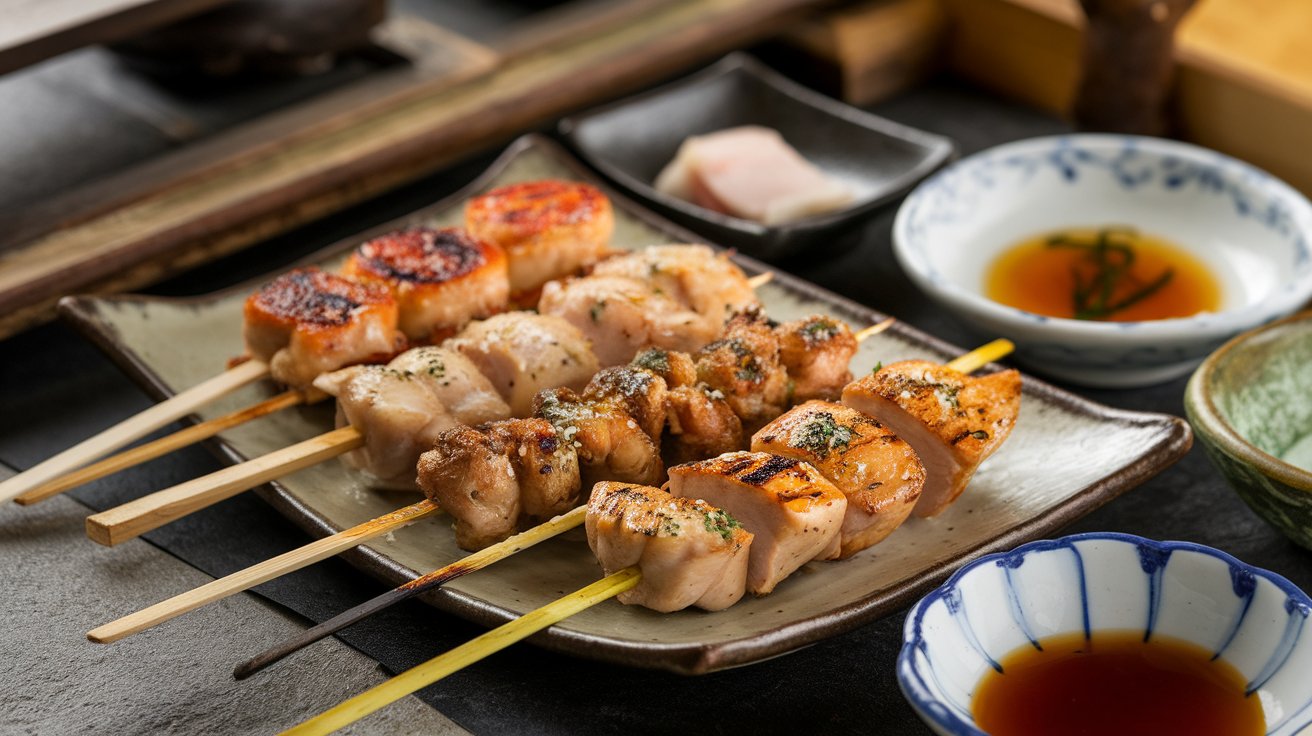
- Description: Skewered and grilled chicken, cooked over charcoal.
- Ingredients: Chicken, scallions, and sometimes other meats or vegetables marinated in tare sauce (a mixture of sake, soy sauce, sugar, and mirin).
- Preparation and Cooking Methods: Skewered ingredients are grilled and frequently turned to cook evenly, often basted with tare sauce.
- Serving Suggestions: Served straight from the grill with a salt sprinkle or a sauce brush.
- Taste Profile: Smoky and savory with a slight sweetness from the sauce.
- Nutritional Information: Low in fat and high in protein, especially when skinless chicken is used.
11. Miso Soup
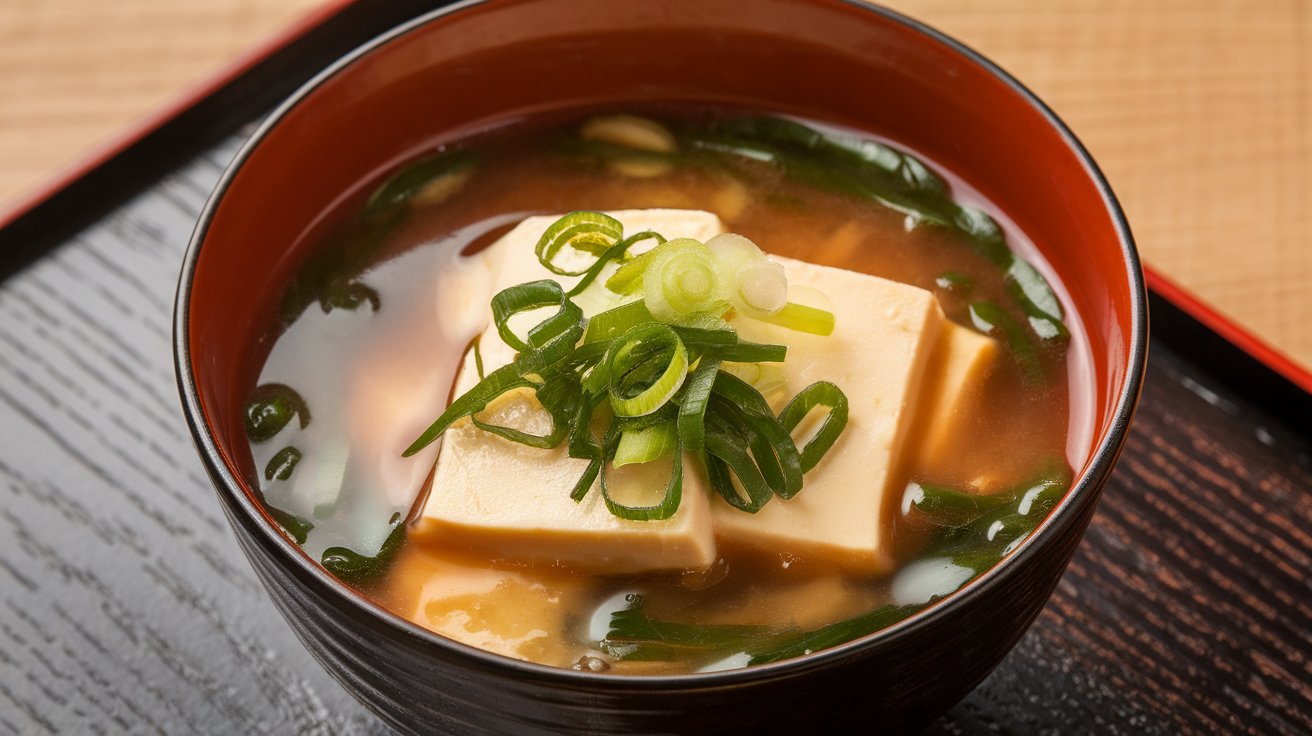
- Description: A traditional Japanese soup made from a miso paste base with ingredients like tofu, seaweed, and scallions.
- Ingredients: Miso paste (fermented soybeans), dashi (broth), tofu, seaweed, and scallions.
- Preparation and Cooking Methods: The dashi is heated, the miso paste is dissolved, and other ingredients are added and heated through.
- Serving Suggestions: Typically served with a rice dish or as part of a larger meal.
- Taste Profile: Salty, savory, with a rich umami flavor.
- Nutritional Information: It is low in calories but high in sodium. It is a good source of protein and beneficial probiotics from the fermented miso.
12. Onigiri
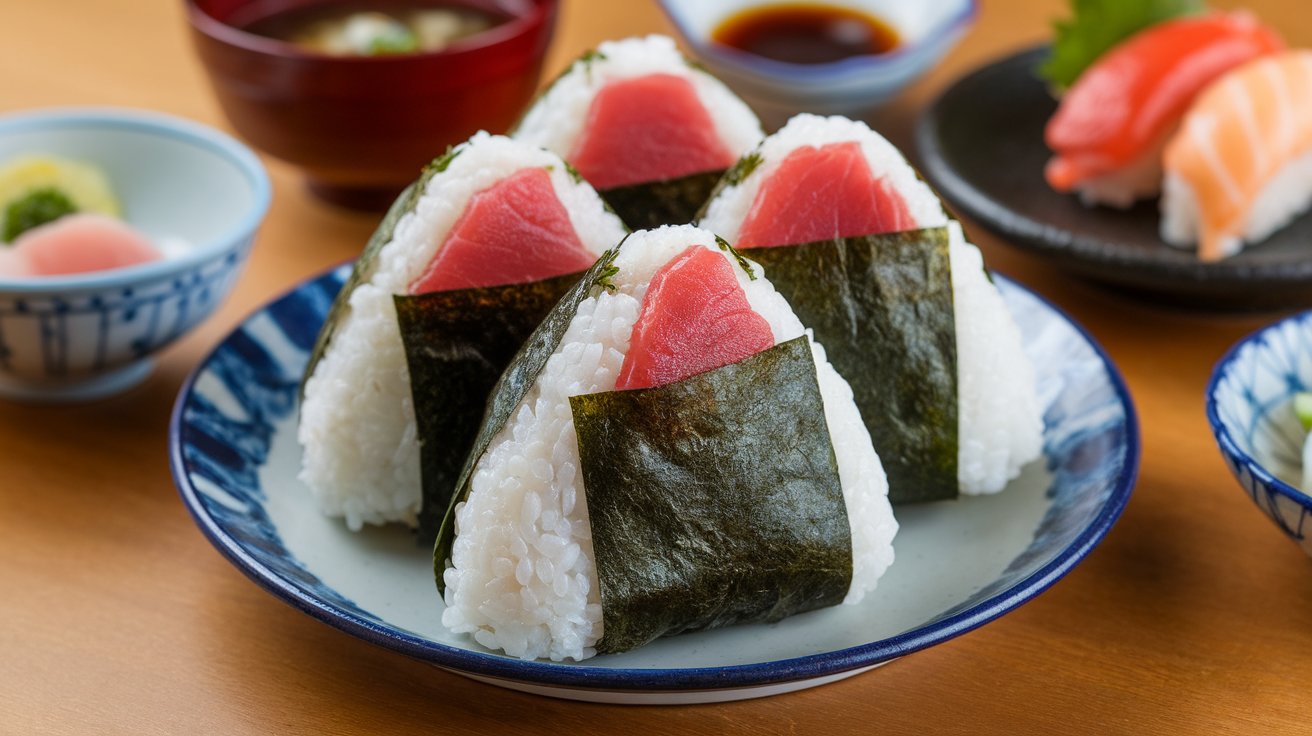
- Description: Japanese rice balls, often shaped into triangles and filled with pickled or salty ingredients.
- Ingredients: White rice, fillings like umeboshi (pickled plums), salted salmon, or kelp, and often wrapped in nori.
- Preparation and Cooking Methods: Cooked rice is salted, shaped into forms with hands, filled, and wrapped in nori.
- Serving Suggestions: Often eaten as a snack or part of a packed meal.
- Taste Profile: The taste is simple, highlighting the salty or sour flavor of the filling.
- Nutritional Information: Primarily carbohydrates; low in fat and moderate in calories, depending on the filling.
13. Curry Rice
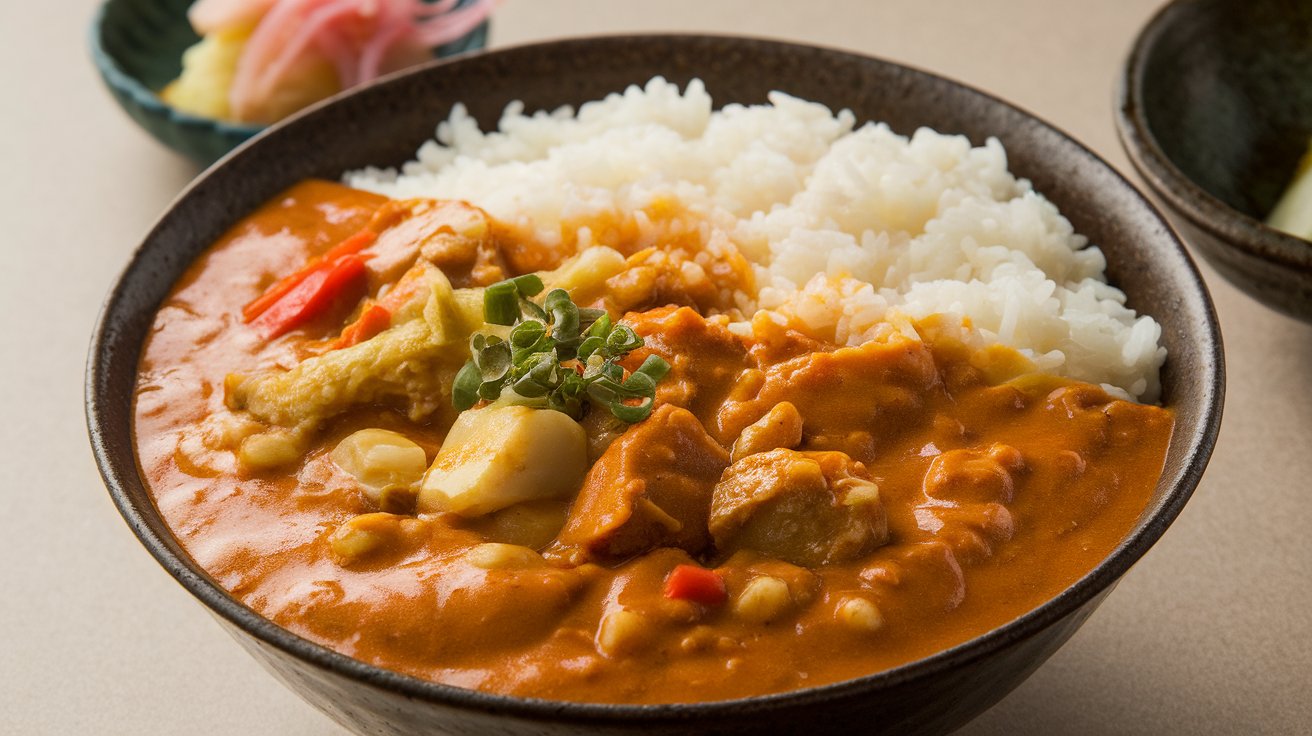
- Description: A hearty dish where thick, mildly spicy curry is served over cooked rice.
- Ingredients: Meat (commonly pork, chicken, or beef), potatoes, carrots, onions, and curry roux.
- Preparation and Cooking Methods: Vegetables and meat are sautéed, water is added and simmered, then curry roux is mixed until thickened.
- Serving Suggestions: Often served with pickled vegetables and sometimes topped with breaded and fried foods like tonkatsu.
- Taste Profile: Rich, slightly spicy, and deeply savory.
- Nutritional Information: High in calories, particularly with fattier meat cuts or when served with fried foods.
14. Bento
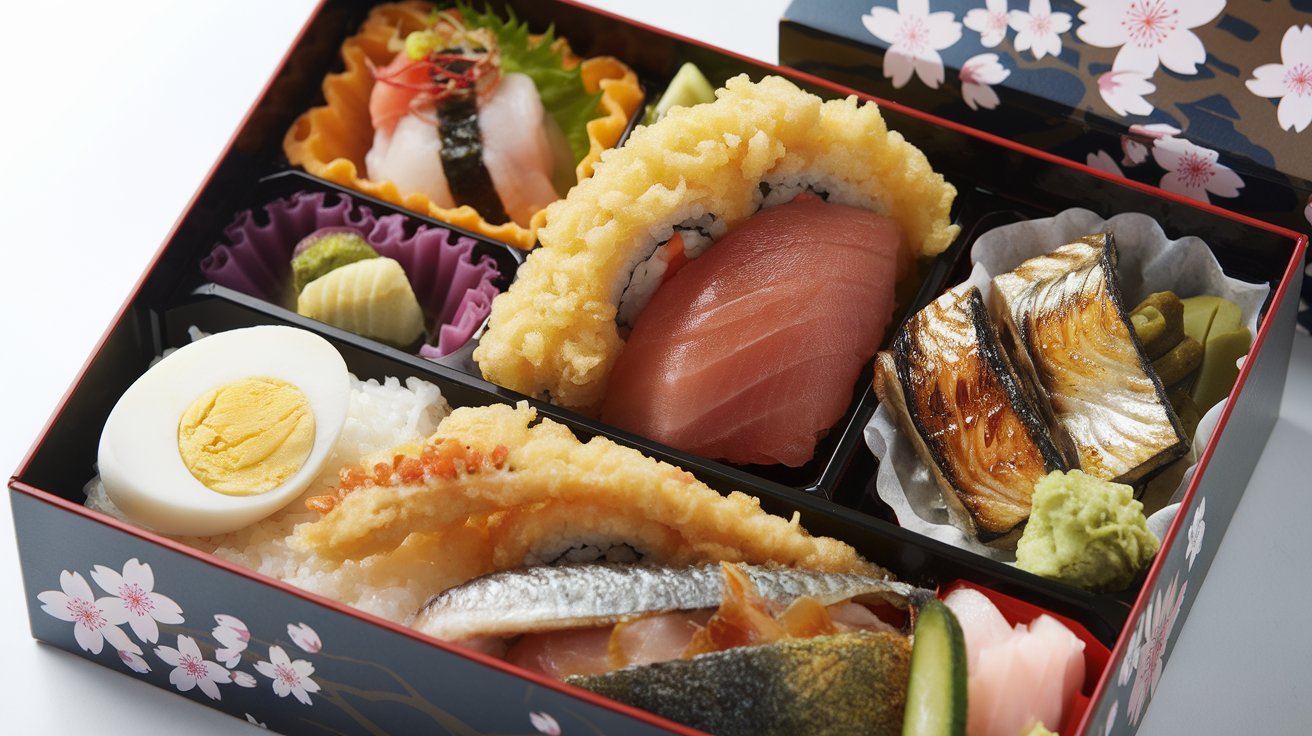
- Description: A single-portion take-out or home-packed meal common in Japanese cuisine.
- Ingredients: Typically includes rice, fish, or meat, pickled or cooked vegetables, and occasionally sweets.
- Preparation and Cooking Methods: Components are cooked separately and arranged neatly in a compartmentalized box.
- Serving Suggestions: Eaten as a packed lunch or convenient meal.
- Taste Profile: Offers a balanced taste with both savory and sweet elements.
- Nutritional Information: Calorie content varies, but bentos are designed to provide a balanced meal with carbs, proteins, and vegetables.
15. Gyoza

- Description: Pan-fried Japanese dumplings filled with ground meat and vegetables.
- Ingredients: Minced pork, cabbage, garlic, ginger, soy sauce, and wrappers made from flour and water.
- Preparation and Cooking Methods: The fillings are wrapped in thin dough, sealed, pan-fried until crispy, and then steamed to finish cooking.
- Serving Suggestions: Served with a dipping sauce made from soy sauce, vinegar, and chili oil.
- Taste Profile: Crispy on the outside, juicy and flavorful on the inside.
- Nutritional Information: Moderate in calories, contains protein from the pork and nutrients from the vegetables.
More Japanese Food Items to Add to Your List
16. Kaiseki – A traditional multi-course Japanese dinner.
17. Shabu-Shabu – Japanese hotpot with thinly sliced meat and vegetables.
18. Sukiyaki – Hotpot with thinly sliced beef, vegetables, and tofu.
19. Tofu – Versatile soybean curd used in various dishes.
20. Natto – Fermented soybeans with a sticky texture and strong flavor.
21. Katsuobushi – Dried, smoked tuna flakes, often used as a topping or flavoring.
22. Oden – A hearty winter hotpot with assorted ingredients.
23. Chawanmushi – Steamed savory egg custard with various mix-ins.
24. Tamagoyaki – Sweet rolled omelet, often found in bento boxes.
25. Fugu – Delicately prepared pufferfish, known for its potential lethality.
26. Karaage – Japanese fried chicken, marinated and coated with seasoned flour.
27. Teriyaki – Grilled or broiled ingredients glazed in a sweet soy sauce marinade.
28. Edamame – Young soybeans, boiled and salted, served as a snack.
29. Matcha – Powdered green tea used in drinks and sweets.
30. Mochi – Sweet rice cakes, soft and chewy.
31. Dango – Sweet dumplings made from rice flour, often served on skewers.
32. Yakisoba – Stir-fried noodles with vegetables and a tangy sauce.
33. Korokke – Croquettes, typically filled with mashed potatoes or ground meat.
34. Senbei – Crunchy rice crackers, available in various flavors.
35. Anko – Sweet red bean paste used in many Japanese sweets.
36. Dorayaki – Sweet pancakes filled with red bean paste.
37. Hokkaido Milk Bread – Soft, fluffy bread popular across Japan.
38. Taiyaki – Fish-shaped cakes filled with sweet red beans or other fillings.
39. Unagi – Grilled freshwater eel, typically glazed with a sweet soy-based sauce.
40. Tebasaki – Nagoya-style spicy chicken wings.
41. Kinpira Gobo – Stir-fried burdock root and carrot seasoned with soy sauce and sugar.
42. Hijiki – A type of seaweed, often simmered with vegetables.
43. Nikujaga – Meat and potato stew, sweetened with sugar and soy sauce.
44. Kakigori – Shaved ice dessert flavored with sweet syrups.
45. Omurice – Fried rice wrapped in a thin omelet, often topped with ketchup.
46. Zaru Soba – Cold buckwheat noodles served with a dipping sauce.
47. Gyudon – Beef bowl with thinly sliced beef and onions over rice.
48. Tsukemono – Pickled vegetables served as a side dish.
49. Shoyu – Soy sauce, a fundamental Japanese condiment.
50. Wasabi – Pungent green paste used as a condiment, especially with sushi.
Summing Up
This journey through exquisite flavors of Japanese cuisine showcases dishes that make up this rich tradition.
From the delicate preparations of Kaiseki to the hearty, comforting bowls of Shabu-Shabu and Sukiyaki, each dish offers a unique insight into the flavors and techniques that define Japanese cooking.
Whether you’re fascinated by the simple yet profound taste of Tofu and Natto or the complex and refined flavors of Fugu and Teriyaki, there’s something in this list for every palate.
Whether dining out or cooking at home, these foods provide a gateway to exploring and enriching your dining experience.
